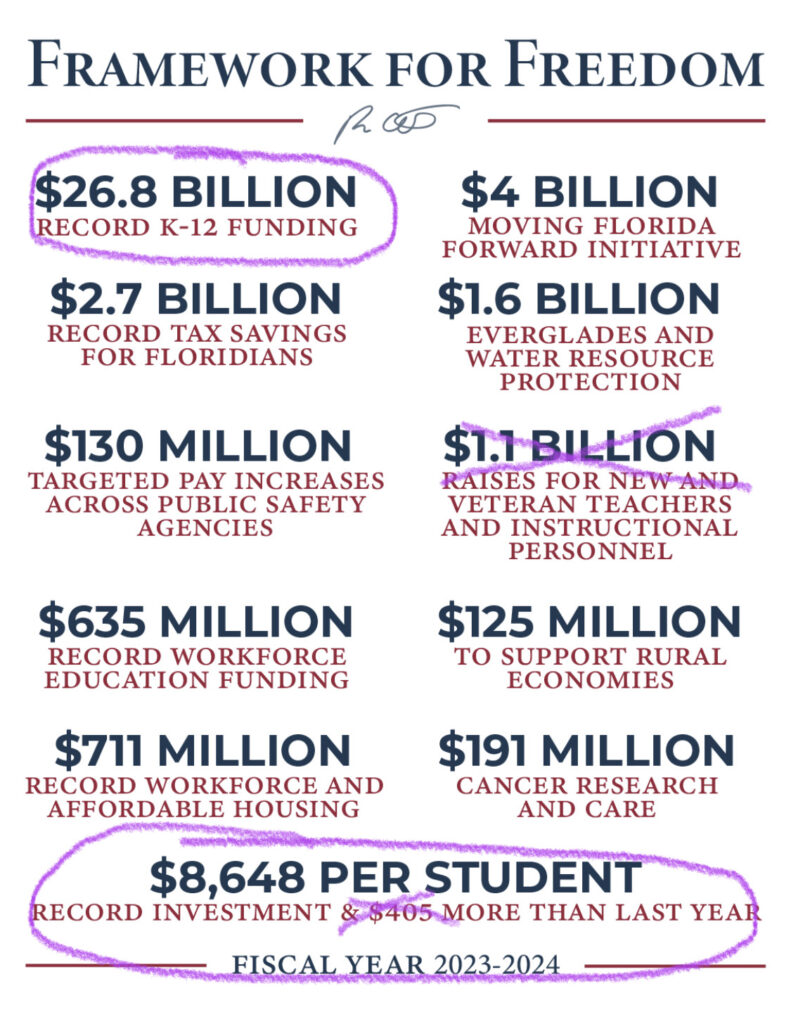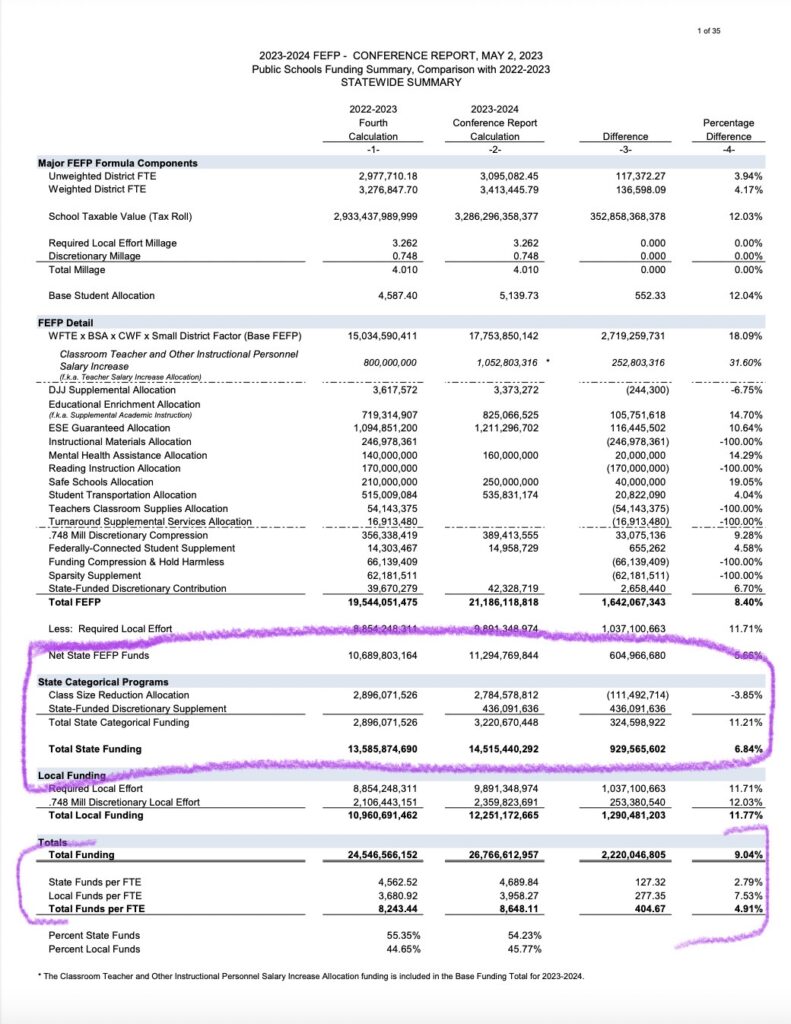As Always, Budgets Reflect Priorities. For Florida’s Public Schools, the 2023-24 Budget Is NOT Worth Celebrating.
Budgets reflect priorities and Florida’s 2023-24 Budget does not prioritize its K-12 public schools. This is no surprise. Despite lawmakers’ insistence that Florida has increased education spending every year for the past decade, when you consider the impacts of inflation, population growth and diversion of public funds to private vouchers, those increases vanish. This year’s budget is no different.
On June 15, 2023, at a yacht club in Ft. Pierce, Governor Ron DeSantis signed Florida’s 2023-24 budget in a campaign style event focused on celebrating the successes of the GOP’s legislative session and record tax cuts in the face of a record budget surplus.
At the bill signing, DeSantis spoke briefly about K-12 education spending in the budget. Specifically:
- He celebrated $1.1 Billion for raises for teachers and instructional personnel, saying “that’s a record.” He pointed out that these funds could only be spent on teacher salaries and “not to bureaucracies or unions.”
- For K-12 funding, he celebrated a “record” $28.6 Billion dollars.
- He also celebrated a record per pupil spending, touting $405 more than last year which, he said, was the previous record.
While multiple news outlets questioned why a veto list wasn’t immediately available and then did deep dives into what appeared to be “vetos as retaliation,” no one seemed to question the Governor’s claims regarding K-12 spending. The Governor’s office was quick to release graphics containing budget highlights. Let’s take a closer look.

- $1.1 Billion for raises for teachers and instructional personnel? Nope. $252 million for raises.
In 2022-23, the Florida Education Finance Program (FEFP), the primary funding formula for K-12 public education in Florida, included $800 million as part of the Teacher Salary Increase Allocation. This year’s FEFP included $1,052,803,316 for Classroom Teacher and Other Instructional Personnel Salary Increase – $800 million to continue previous year’s salary increases and $252,803,316 million for new raises. While it is great that the state is funding teacher raises, it is an exaggeration to suggest $1.1 billion was spent on raises this year.
- Record K-12 Funding? Again, Nope – Not when adjusted for inflation and population growth.
The high water mark for K-12 Funding in Florida was Gov. Charlie Christ’s final budget in 2007-08, before the Great Recession and Gov. Rick Scott’s dramatic budget cuts to public education. Public education funding in Florida has never recovered, despite massive budget surpluses over the last 2 years. Florida’s 2007-08 Budget included an FEFP with a per pupil spending of $7305.79, which adjusted for inflation would equal $10,716.05 in today’s dollars, far higher than the $8,648 celebrated in DeSantis’ new budget.
In addition, the student population has grown significantly since 2007, when the budget funded 2.642 million students. This year, following years of population growth and this year’s expansion of publicly funded vouchers to all private school students, the FEFP funds 3.095 million students (over 450,000 more than in 2007). If today’s population of students were funded at the inflation adjusted 2007 levels, it would cost $33.2 Billion, vastly more than the $26.8 billion “record” celebrated by DeSantis.
other budget shenanigans:
Warning, this is going to get weedy and math-heavy.
Changes to the FEFP
During the 2023 Legislative session, lawmakers significantly revamped the FEFP formula in an effort to “modernize” it and “align it with the state’s school choice policy” (i.e. “the money follows the child”). You can read the details on pg 6 of the staff analysis of the budget bill, HB5101. They repealed multiple categoricals, including Instructional Materials Allocation, Reading Instruction Allocation, Teacher Classroom Supply Assistance and Teacher Salary Increase Allocation, and rolled their funding into the Base Student funding. The net result was to increase the Base Student Allocation (BSA) by $552.33 or 12.04%.
How much of that 12.4% increase was “new money” and how much was due to rolling in the repealed categoricals?
I calculated what last year’s 2022-23 BSA calculation would have been if the new changes to the formula had been in place. To do this, I added the 22-23 funding values for the repealed categoricals to the Base FEFP for 22-23.
After adding:
- Teacher Salary Increase Allocation ($800 million)
- Instructional Materials Allocation ($246,978,361)
- Reading Instruction Allocation ($170 million)
- Teachers Classroom Supplies Allocation ($54,143,375)
- Funding Compression and Hold Harmless ($66,139,409)
- Sparsity Supplement ($62,181,511)
to the Base FEFP ($15,034,590,411), the recalculated BSA for 2022-23 was $5014.44, which is $125.33 less than the new 2023-24 BSA of $5,139.73.
In other words, the new 2023-24 BSA only increased by $125.33 over last year’s (a 2.5% increase in the BSA), NOT the reported increase of 12.04%. It is important to note that 2.5% (the “new” increase in the BSA) is significantly less than the current annual inflation rate of 4.91%.
In a year when the State had record budget surpluses, the “real” increase in the 2023-24 Base Student Allocation FAILED to keep up with inflation. This, essentially, defunds public schools.
Decreased State Funding in a time of surplus? It appears so.
In addition to a BSA that fails to keep up with inflation, the amount of state funding going towards public schools declines as well. Take a look at the “State Categorical Programs” and Total State Funding in the 2023-24 FEFP.

Florida’s FEFP is funded by both Local and State dollars. Notice the addition of the New State-Funded Discretionary Supplement ($436 million) to the State Categorical Programs. This funding ONLY goes to voucher recipients, not public schools. Notice, also, that the State funding of the Class Size Reduction Categorical actually decreases 3.85% from 2022-23. If you remove the State Funded Discretionary Supplement from the calculation (since it is new funding only for voucher students), the Total State Funding for public schools drops to $14,079,348,656, an increase of $493 million, or 3.63% (NOT the reported increase of 6.84%).
When the New State-Funded Discretionary Supplement is removed from the FEFP calculation,
- The Total Funds per FEFP is only $8,507.21, a 3.2% (NOT the reported 4.91%) increase.
- And the State Funds per FEFP is reduced to $4548.94, a REDUCTION of $13.58 (-0.3%) per student, NOT the 2.79% increase reported.
The new FEFP funds $2,035,027,608 for Family Empowerment Scholarships (PAGE 7 OF 2023-24 FEFP). This is a 45.7% increase over the $1,396,924,129 funded last year.
Budget reflect priorities.
Florida’s 2023-24 FEFP clearly demonstrates its priorities.
- A BSA that fails to keep up with inflation.
- A 45.7% increase in publicly funded private school voucher programs.
- A 0.3% decrease in State Funds per FTE to public schools.
For Florida’s public schools, this is nothing to celebrate.
